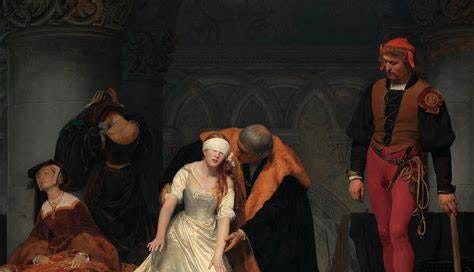We Can't Save Lady Jane Grey
What does the ending of Lady Jane Grey (2024) mean for all of us?
Starting this review off sounding like an indie boy with a superiority complex: I watched My Lady Jane before it blew up. You may be wondering — Emma, the show just came out with its first season; how is that possible? The truth it I have been anxiously awaiting the show to come out for a month, after seeing an ad in The Boys featuring the beloved heroine. I knew of Lady Jane Grey because of a particular painting I had always felt connected to.
What she was best known for was her death — immortalized by the painter Paul Delaroche. She is the picture of meek fragility. Her last words were allegedly an apology to the executioner for stepping on his shoe as she struggled to find the mound she was to be beheaded. At first, I was inspired a woman could remain so kind and meek even when faced with such violence. As I grew older (and subsequently more jaded) this fact angered me. To die with such grace; to make it easy for the audience to digest your own murder. My rage of course was not directed at Jane, but rather the forces that brought her to her knees.
My Lady Jane is not a retelling, but a reimagining of her entire life. It was based on the novel by the same name My Lady Jane by Cynthia Hand, Brodi Ashton, and Jodi Meadows. Though I have not read the book, what stands out to me about its summary is the final line “[With] only a passing resemblance to actual history—because sometimes history needs a little help.” Changes include but are not limited to aging up Jane to be eighteen, a race of people who can change into animals (Ethians), Sky from Mamma Mia getting spanked by Mary, and Jane’s mother having a situationship with Jane’s husband’s brother.
Though entirely fantastical, the changes made are refreshing. What’s even more refreshing is how the character of Jane overtly fights against the persecution of the Ethian people. Though it was Jane’s stark beliefs that brought her close to death, it was her complete conviction in them that saved her life. This is why the show is refreshing, persecution is not used as the backdrop, it’s at the forefront.
In other historically inaccurate shows (such as Bridgerton), the patriarchy is the setting. Balls, gowns, and marriages permeate the show. Naturally, the show is a regency romance show, and characters acknowledge that; however, when self-righteous characters talk about the changes, they’d make to society with absolutely no follow-through, audiences get tired. Though the patriarchy a primary force in Jane’s life, she refuses to be a victim to it, and instead chooses to fight to the very end.
Sometimes, I am naive enough to believe I can re-write my past. That if I could just have five minutes with my past-self I can save myself from what awaits her. The beauty of the show is that you know there is a Jane Grey out there who did not escape this fate, but now there is one who did. I may not be able to save my past self, but it’s not too late to re-write my future; it is not too late to have hope.
During the final scene of the show, I couldn’t stop crying. Though I knew the story would end differently, I wept for the privilege to watch this show — one that was female lead, female written, and female directed. Even with the insanity happening in the world right now, it was a pocket of peace I found. Though Lady Jane Grey rests in her grave now, we are still alive with time to fight.
So no, we cannot save Lady Jane Grey, but maybe she can save us.





